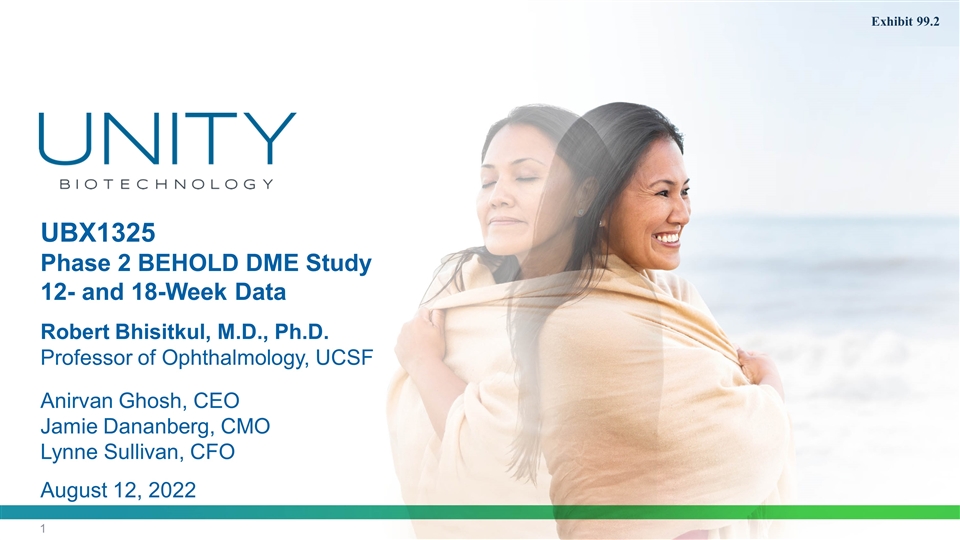
UBX1325 Phase 2 BEHOLD DME Study 12- and 18-Week Data August 12, 2022 Robert Bhisitkul, M.D., Ph.D. Professor of Ophthalmology, UCSF Anirvan Ghosh, CEO Jamie Dananberg, CMO Lynne Sullivan, CFO Exhibit 99.2
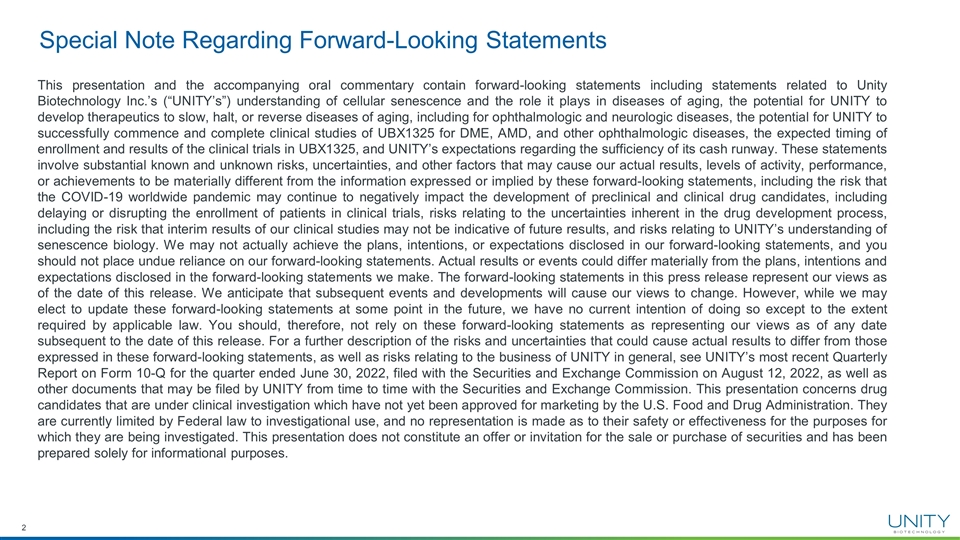
Special Note Regarding Forward-Looking Statements This presentation and the accompanying oral commentary contain forward-looking statements including statements related to Unity Biotechnology Inc.’s (“UNITY’s”) understanding of cellular senescence and the role it plays in diseases of aging, the potential for UNITY to develop therapeutics to slow, halt, or reverse diseases of aging, including for ophthalmologic and neurologic diseases, the potential for UNITY to successfully commence and complete clinical studies of UBX1325 for DME, AMD, and other ophthalmologic diseases, the expected timing of enrollment and results of the clinical trials in UBX1325, and UNITY’s expectations regarding the sufficiency of its cash runway. These statements involve substantial known and unknown risks, uncertainties, and other factors that may cause our actual results, levels of activity, performance, or achievements to be materially different from the information expressed or implied by these forward-looking statements, including the risk that the COVID-19 worldwide pandemic may continue to negatively impact the development of preclinical and clinical drug candidates, including delaying or disrupting the enrollment of patients in clinical trials, risks relating to the uncertainties inherent in the drug development process, including the risk that interim results of our clinical studies may not be indicative of future results, and risks relating to UNITY’s understanding of senescence biology. We may not actually achieve the plans, intentions, or expectations disclosed in our forward-looking statements, and you should not place undue reliance on our forward-looking statements. Actual results or events could differ materially from the plans, intentions and expectations disclosed in the forward-looking statements we make. The forward-looking statements in this press release represent our views as of the date of this release. We anticipate that subsequent events and developments will cause our views to change. However, while we may elect to update these forward-looking statements at some point in the future, we have no current intention of doing so except to the extent required by applicable law. You should, therefore, not rely on these forward-looking statements as representing our views as of any date subsequent to the date of this release. For a further description of the risks and uncertainties that could cause actual results to differ from those expressed in these forward-looking statements, as well as risks relating to the business of UNITY in general, see UNITY’s most recent Quarterly Report on Form 10-Q for the quarter ended June 30, 2022, filed with the Securities and Exchange Commission on August 12, 2022, as well as other documents that may be filed by UNITY from time to time with the Securities and Exchange Commission. This presentation concerns drug candidates that are under clinical investigation which have not yet been approved for marketing by the U.S. Food and Drug Administration. They are currently limited by Federal law to investigational use, and no representation is made as to their safety or effectiveness for the purposes for which they are being investigated. This presentation does not constitute an offer or invitation for the sale or purchase of securities and has been prepared solely for informational purposes.
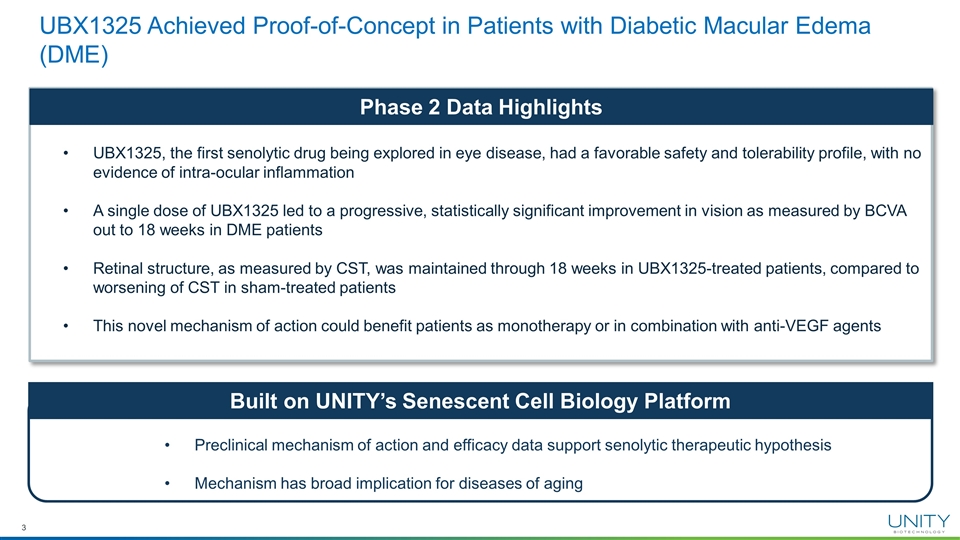
UBX1325 Achieved Proof-of-Concept in Patients with Diabetic Macular Edema (DME) Built on UNITY’s Senescent Cell Biology Platform UBX1325, the first senolytic drug being explored in eye disease, had a favorable safety and tolerability profile, with no evidence of intra-ocular inflammation A single dose of UBX1325 led to a progressive, statistically significant improvement in vision as measured by BCVA out to 18 weeks in DME patients Retinal structure, as measured by CST, was maintained through 18 weeks in UBX1325-treated patients, compared to worsening of CST in sham-treated patients This novel mechanism of action could benefit patients as monotherapy or in combination with anti-VEGF agents Preclinical mechanism of action and efficacy data support senolytic therapeutic hypothesis Mechanism has broad implication for diseases of aging Phase 2 Data Highlights
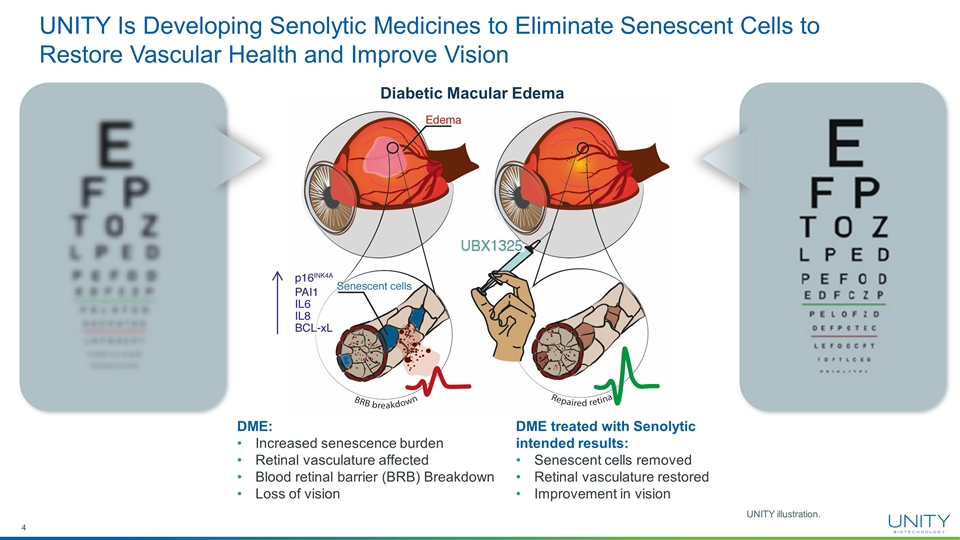
UNITY Is Developing Senolytic Medicines to Eliminate Senescent Cells to Restore Vascular Health and Improve Vision DME: Increased senescence burden Retinal vasculature affected Blood retinal barrier (BRB) Breakdown Loss of vision DME treated with Senolytic intended results: Senescent cells removed Retinal vasculature restored Improvement in vision BRB Breakdown Repaired Retina UNITY illustration. Diabetic Macular Edema
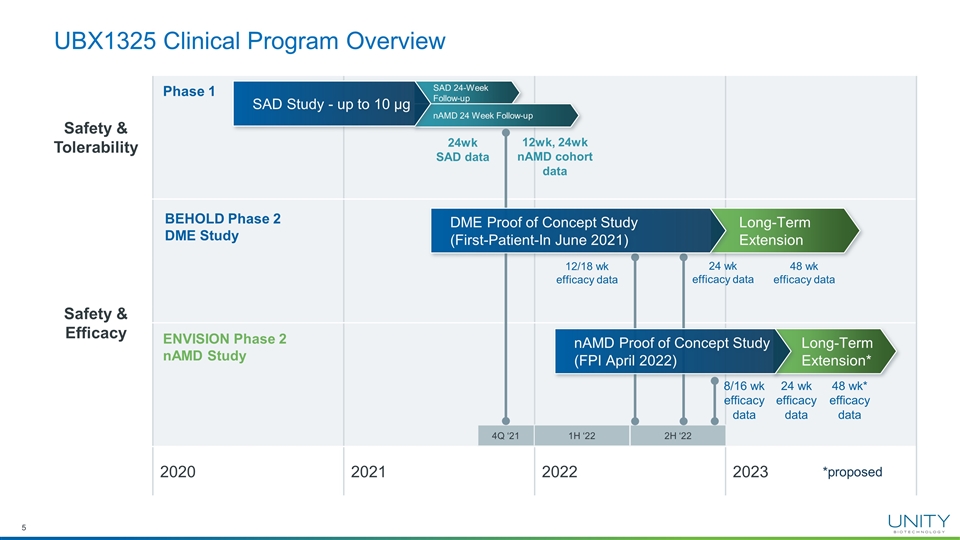
UBX1325 Clinical Program Overview Safety & Tolerability Safety & Efficacy 2020 2021 2022 2023 Phase 1 ENVISION Phase 2 nAMD Study BEHOLD Phase 2 DME Study SAD 24-Week Follow-up nAMD 24 Week Follow-up SAD Study - up to 10 µg 4Q ‘21 1H ‘22 2H ‘22 Long-Term Extension DME Proof of Concept Study (First-Patient-In June 2021) Long-Term Extension* nAMD Proof of Concept Study (FPI April 2022) 12wk, 24wk nAMD cohort data 12/18 wk efficacy data 8/16 wk efficacy data 24wk SAD data 24 wk efficacy data 24 wk efficacy data 48 wk efficacy data 48 wk* efficacy data *proposed

UBX1325 Phase 2 BEHOLD Study Historic Data on DME Patients treated with Standard of Care Differences in Patient Population in Ph1 and Ph2 Studies
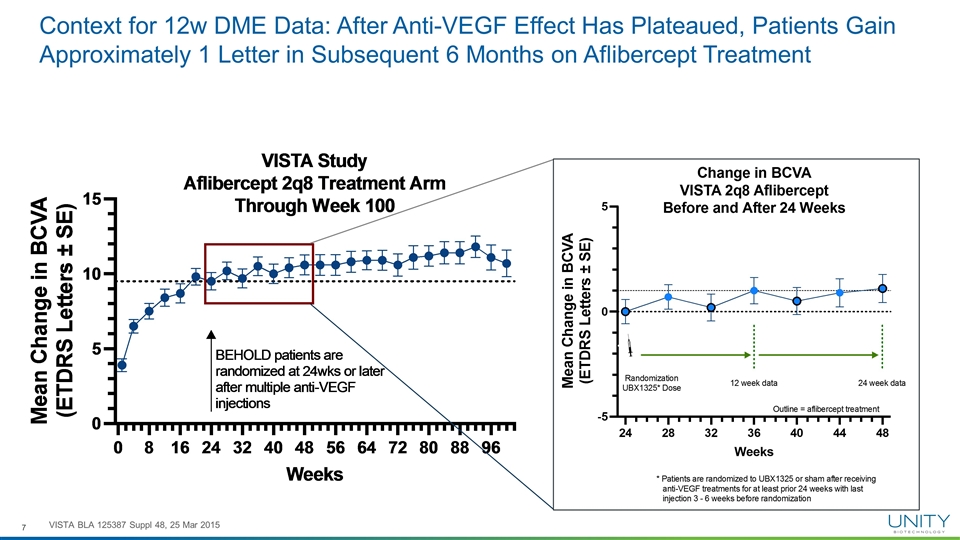
Context for 12w DME Data: After Anti-VEGF Effect Has Plateaued, Patients Gain Approximately 1 Letter in Subsequent 6 Months on Aflibercept Treatment VISTA BLA 125387 Suppl 48, 25 Mar 2015
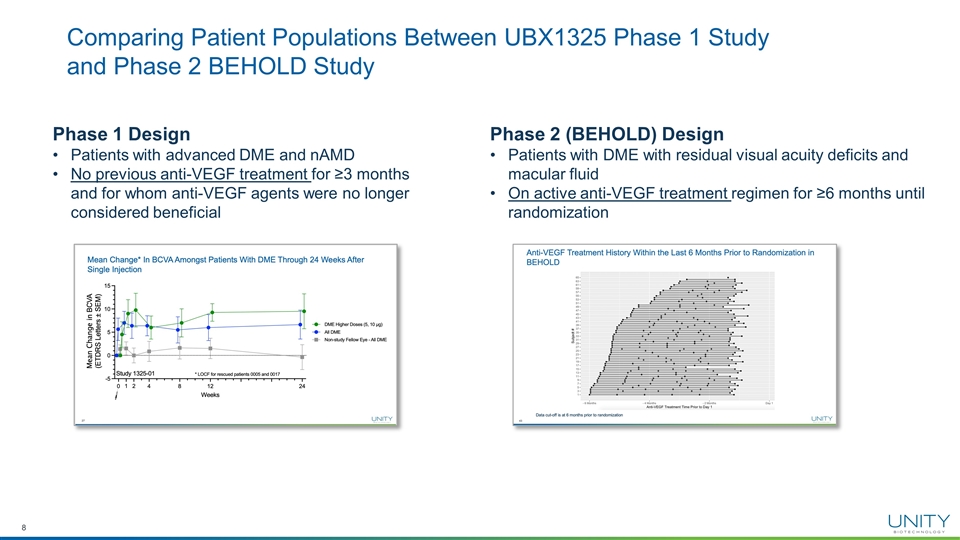
Comparing Patient Populations Between UBX1325 Phase 1 Study and Phase 2 BEHOLD Study Phase 1 Design Patients with advanced DME and nAMD No previous anti-VEGF treatment for ≥3 months and for whom anti-VEGF agents were no longer considered beneficial Phase 2 (BEHOLD) Design Patients with DME with residual visual acuity deficits and macular fluid On active anti-VEGF treatment regimen for ≥6 months until randomization
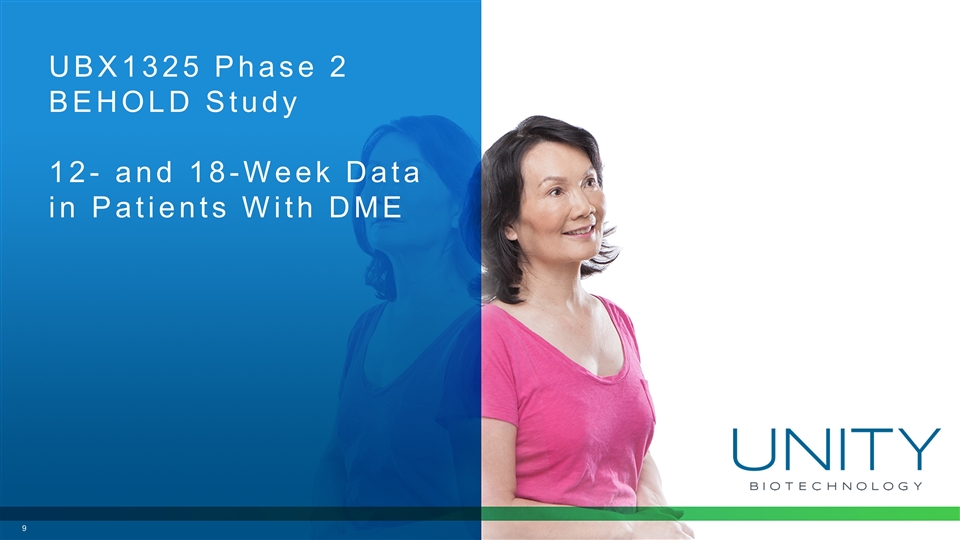
UBX1325 Phase 2 BEHOLD Study 12- and 18-Week Data in Patients With DME
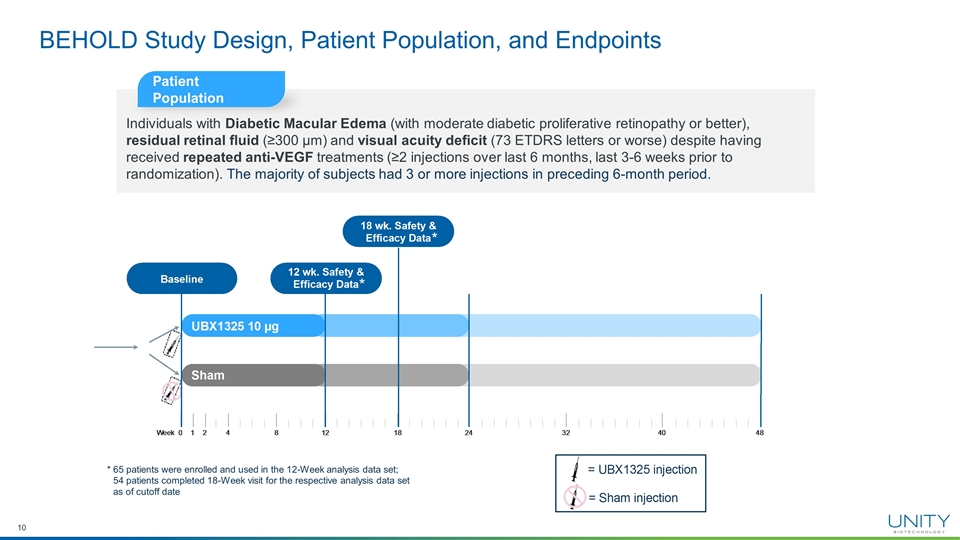
BEHOLD Study Design, Patient Population, and Endpoints Individuals with Diabetic Macular Edema (with moderate diabetic proliferative retinopathy or better), residual retinal fluid (≥300 µm) and visual acuity deficit (73 ETDRS letters or worse) despite having received repeated anti-VEGF treatments (≥2 injections over last 6 months, last 3-6 weeks prior to randomization). The majority of subjects had 3 or more injections in preceding 6-month period. Patient Population * * *65 patients were enrolled and used in the 12-Week analysis data set; 54 patients completed 18-Week visit for the respective analysis data set as of cutoff date
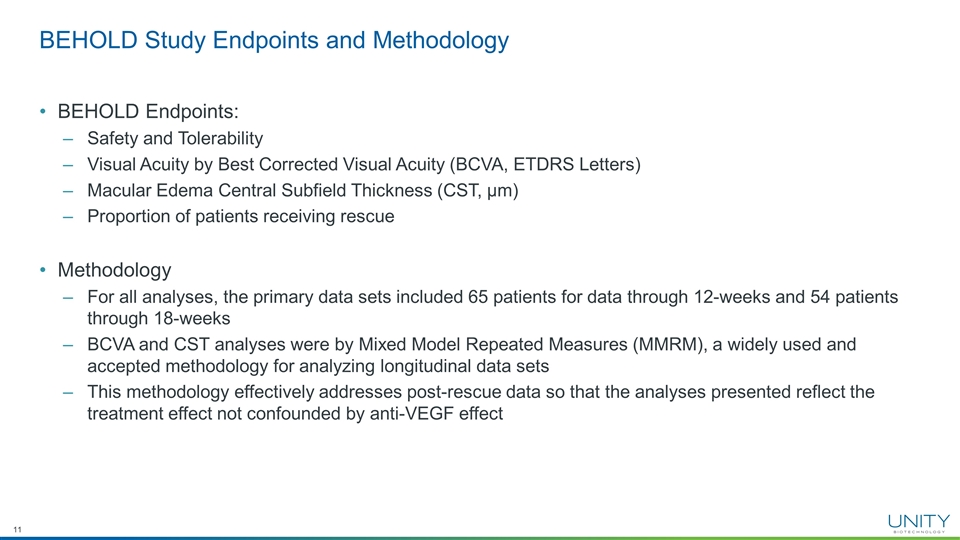
BEHOLD Study Endpoints and Methodology BEHOLD Endpoints: Safety and Tolerability Visual Acuity by Best Corrected Visual Acuity (BCVA, ETDRS Letters) Macular Edema Central Subfield Thickness (CST, µm) Proportion of patients receiving rescue Methodology For all analyses, the primary data sets included 65 patients for data through 12-weeks and 54 patients through 18-weeks BCVA and CST analyses were by Mixed Model Repeated Measures (MMRM), a widely used and accepted methodology for analyzing longitudinal data sets This methodology effectively addresses post-rescue data so that the analyses presented reflect the treatment effect not confounded by anti-VEGF effect
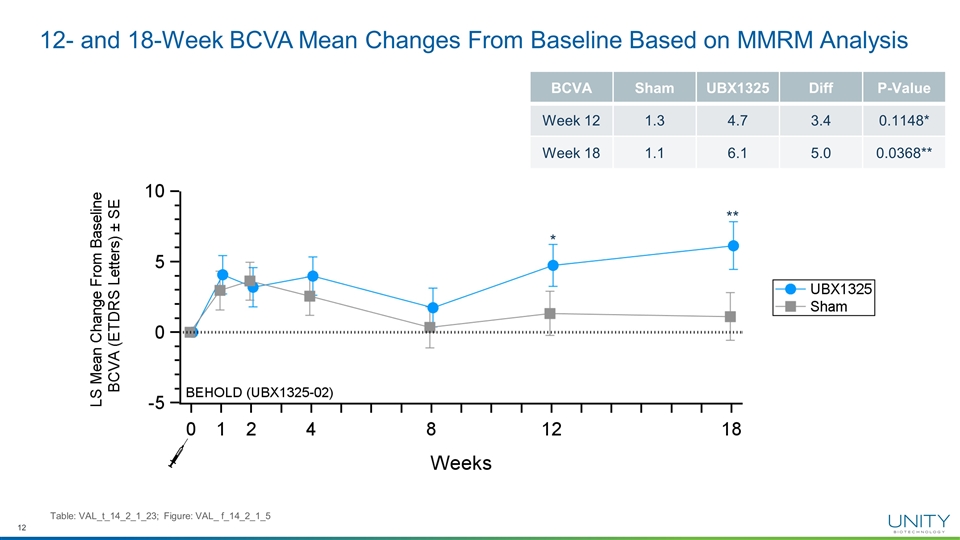
12- and 18-Week BCVA Mean Changes From Baseline Based on MMRM Analysis Table: VAL_t_14_2_1_23; Figure: VAL_ f_14_2_1_5 BCVA Sham UBX1325 Diff P-Value Week 12 1.3 4.7 3.4 0.1148* Week 18 1.1 6.1 5.0 0.0368** * **
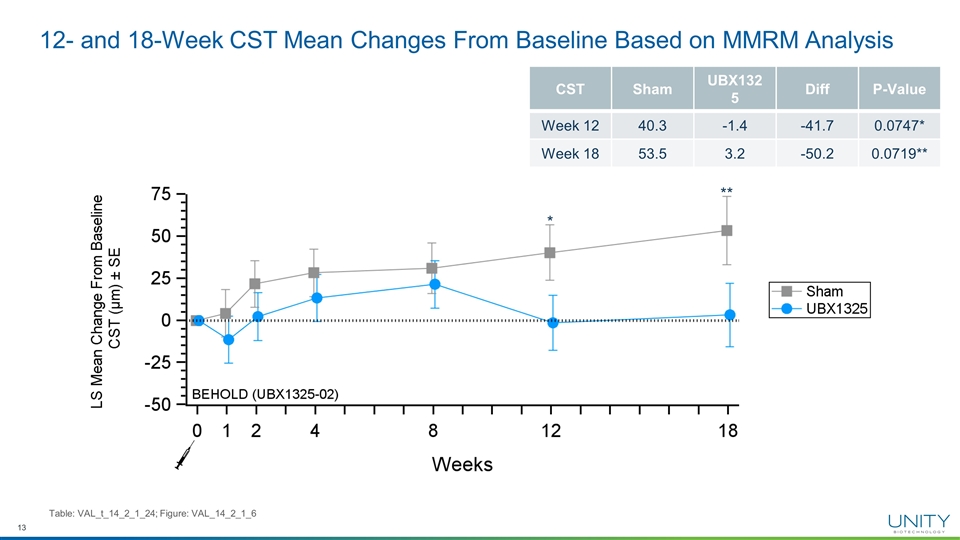
12- and 18-Week CST Mean Changes From Baseline Based on MMRM Analysis Table: VAL_t_14_2_1_24; Figure: VAL_14_2_1_6 CST Sham UBX1325 Diff P-Value Week 12 40.3 -1.4 -41.7 0.0747* Week 18 53.5 3.2 -50.2 0.0719** * **
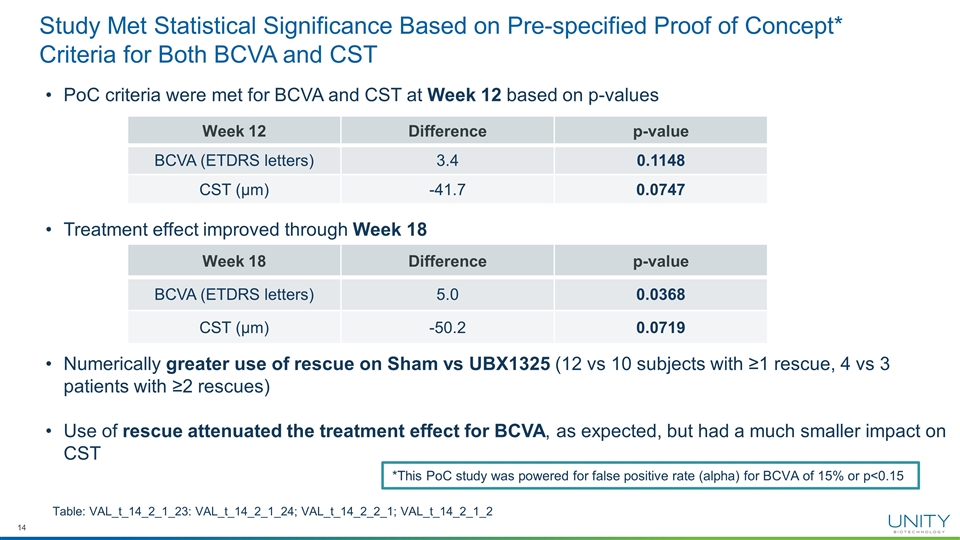
Study Met Statistical Significance Based on Pre-specified Proof of Concept* Criteria for Both BCVA and CST PoC criteria were met for BCVA and CST at Week 12 based on p-values Treatment effect improved through Week 18 Numerically greater use of rescue on Sham vs UBX1325 (12 vs 10 subjects with ≥1 rescue, 4 vs 3 patients with ≥2 rescues) Use of rescue attenuated the treatment effect for BCVA, as expected, but had a much smaller impact on CST *This PoC study was powered for false positive rate (alpha) for BCVA of 15% or p<0.15 Table: VAL_t_14_2_1_23: VAL_t_14_2_1_24; VAL_t_14_2_2_1; VAL_t_14_2_1_2 Week 12 Difference p-value BCVA (ETDRS letters) 3.4 0.1148 CST (µm) -41.7 0.0747 Week 18 Difference p-value BCVA (ETDRS letters) 5.0 0.0368 CST (µm) -50.2 0.0719
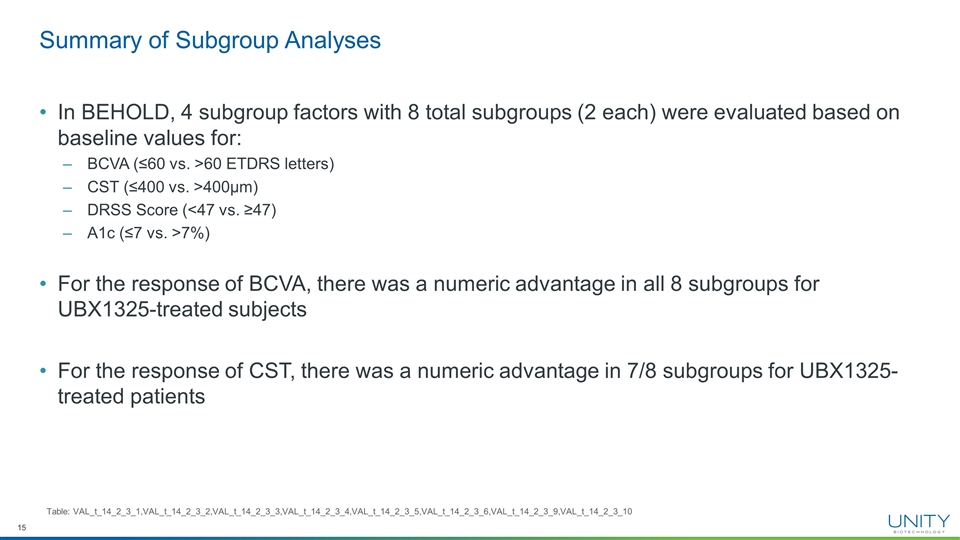
Summary of Subgroup Analyses In BEHOLD, 4 subgroup factors with 8 total subgroups (2 each) were evaluated based on baseline values for: BCVA (≤60 vs. >60 ETDRS letters) CST (≤400 vs. >400µm) DRSS Score (<47 vs. ≥47) A1c (≤7 vs. >7%) For the response of BCVA, there was a numeric advantage in all 8 subgroups for UBX1325-treated subjects For the response of CST, there was a numeric advantage in 7/8 subgroups for UBX1325-treated patients Confidential 15-Jun-2021 Table: VAL_t_14_2_3_1,VAL_t_14_2_3_2,VAL_t_14_2_3_3,VAL_t_14_2_3_4,VAL_t_14_2_3_5,VAL_t_14_2_3_6,VAL_t_14_2_3_9,VAL_t_14_2_3_10
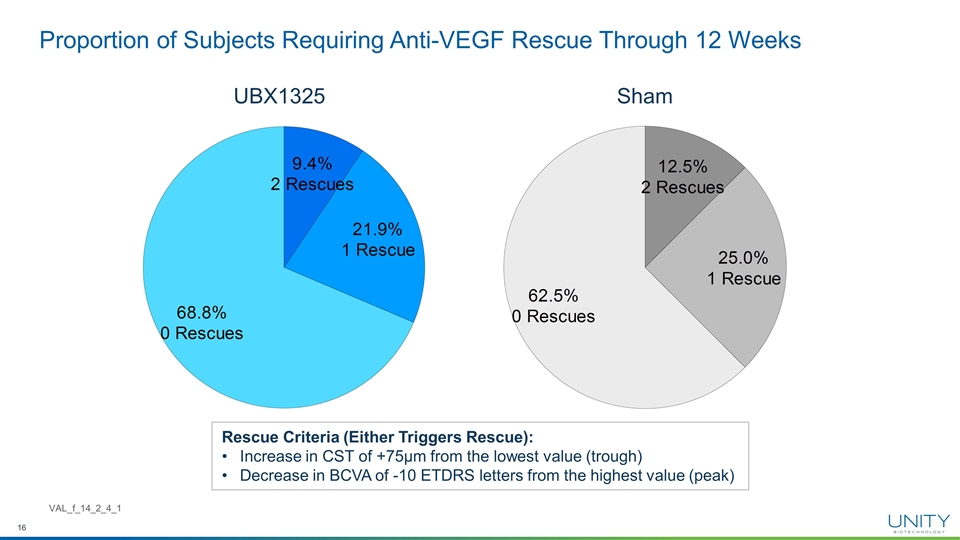
Proportion of Subjects Requiring Anti-VEGF Rescue Through 12 Weeks VAL_f_14_2_4_1 UBX1325 Sham Rescue Criteria (Either Triggers Rescue): Increase in CST of +75µm from the lowest value (trough) Decrease in BCVA of -10 ETDRS letters from the highest value (peak)
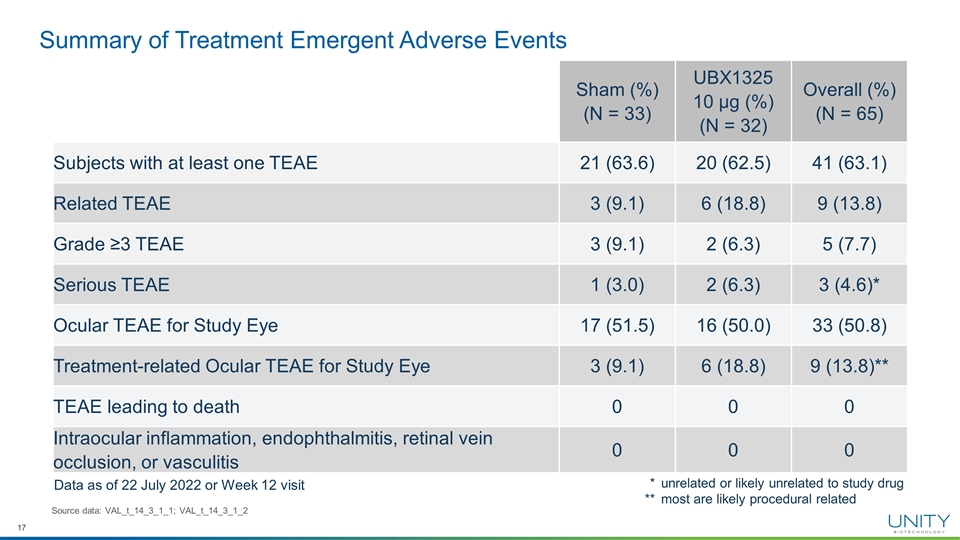
Summary of Treatment Emergent Adverse Events Source data: VAL_t_14_3_1_1; VAL_t_14_3_1_2 Sham (%) (N = 33) UBX1325 10 µg (%) (N = 32) Overall (%) (N = 65) Subjects with at least one TEAE 21 (63.6) 20 (62.5) 41 (63.1) Related TEAE 3 (9.1) 6 (18.8) 9 (13.8) Grade ≥3 TEAE 3 (9.1) 2 (6.3) 5 (7.7) Serious TEAE 1 (3.0) 2 (6.3) 3 (4.6)* Ocular TEAE for Study Eye 17 (51.5) 16 (50.0) 33 (50.8) Treatment-related Ocular TEAE for Study Eye 3 (9.1) 6 (18.8) 9 (13.8)** TEAE leading to death 0 0 0 Intraocular inflammation, endophthalmitis, retinal vein occlusion, or vasculitis 0 0 0 *unrelated or likely unrelated to study drug **most are likely procedural related Data as of 22 July 2022 or Week 12 visit
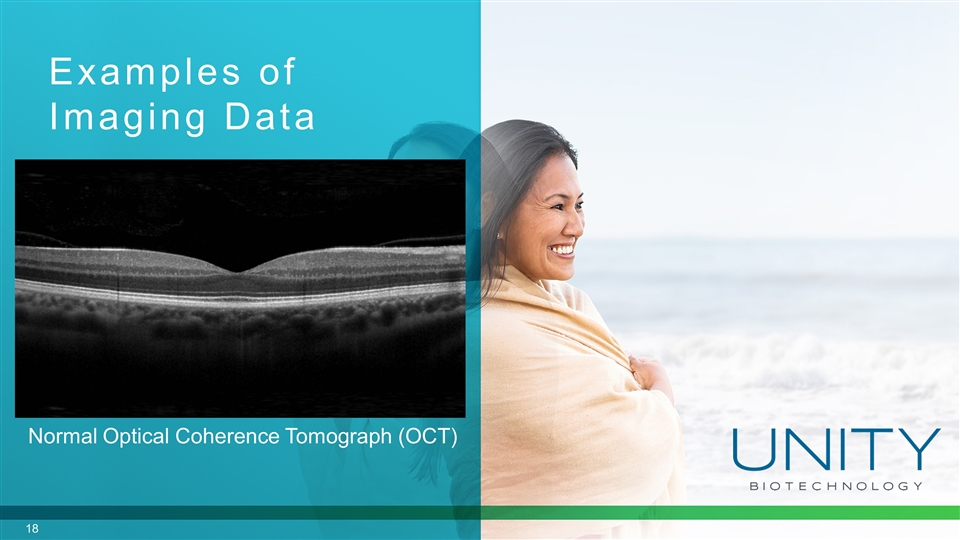
Examples of Imaging Data Normal Optical Coherence Tomograph (OCT)
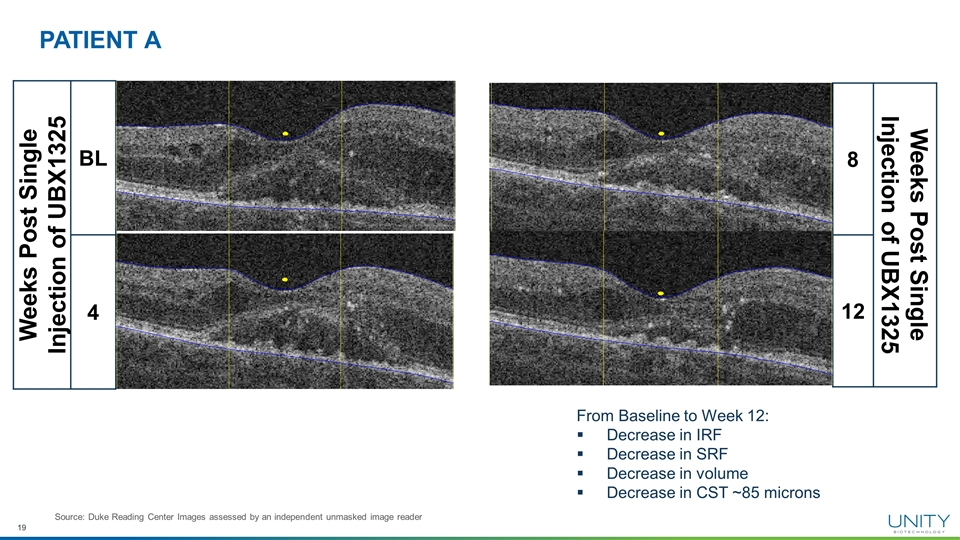
PATIENT A Weeks Post Single Injection of UBX1325 BL 4 8 Weeks Post Single Injection of UBX1325 12 From Baseline to Week 12: Decrease in IRF Decrease in SRF Decrease in volume Decrease in CST ~85 microns Source: Duke Reading Center Images assessed by an independent unmasked image reader
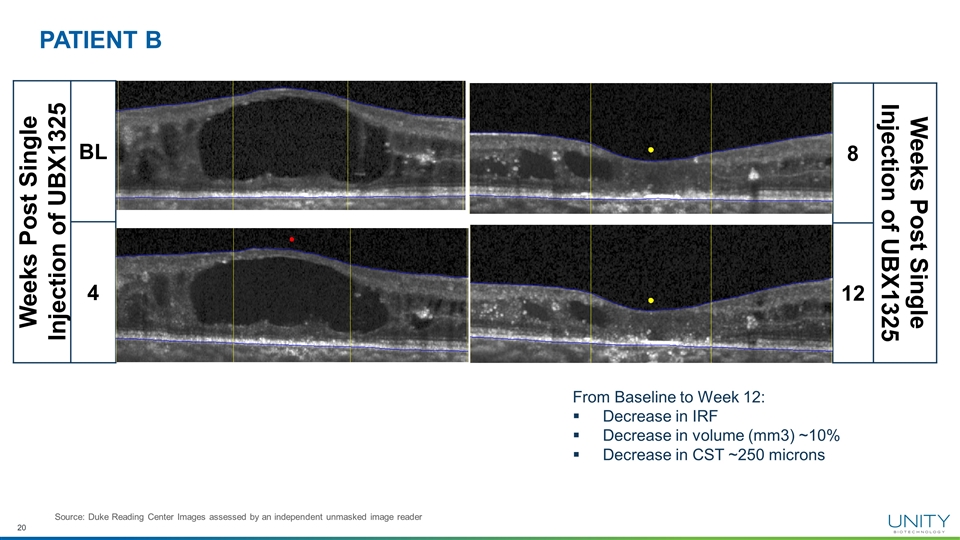
PATIENT B Weeks Post Single Injection of UBX1325 BL 4 8 Weeks Post Single Injection of UBX1325 12 From Baseline to Week 12: Decrease in IRF Decrease in volume (mm3) ~10% Decrease in CST ~250 microns Source: Duke Reading Center Images assessed by an independent unmasked image reader
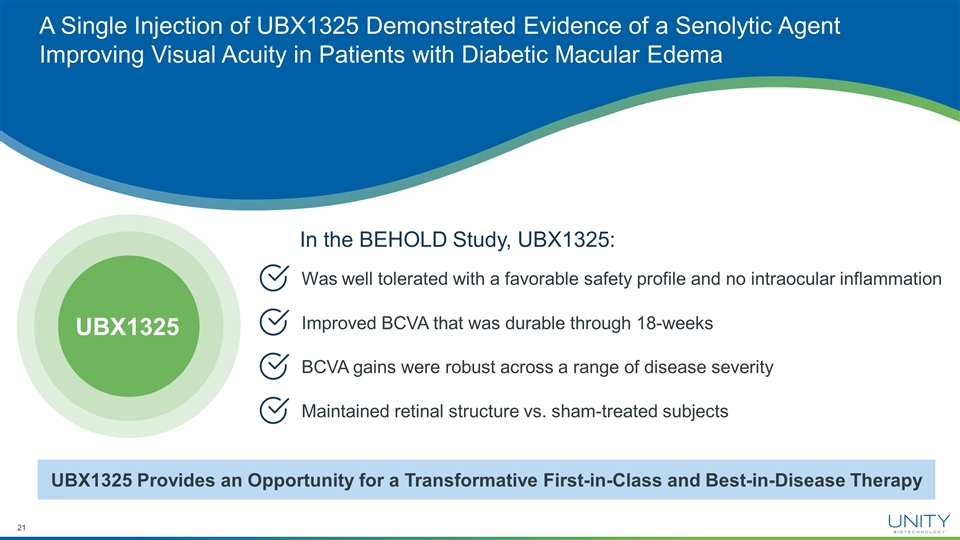
A Single Injection of UBX1325 Demonstrated Evidence of a Senolytic Agent Improving Visual Acuity in Patients with Diabetic Macular Edema Was well tolerated with a favorable safety profile and no intraocular inflammation Improved BCVA that was durable through 18-weeks Maintained retinal structure vs. sham-treated subjects BCVA gains were robust across a range of disease severity @Vicki Can we make the this slide a little more punchy/less flat? UBX1325 UBX1325 Provides an Opportunity for a Transformative First-in-Class and Best-in-Disease Therapy In the BEHOLD Study, UBX1325:
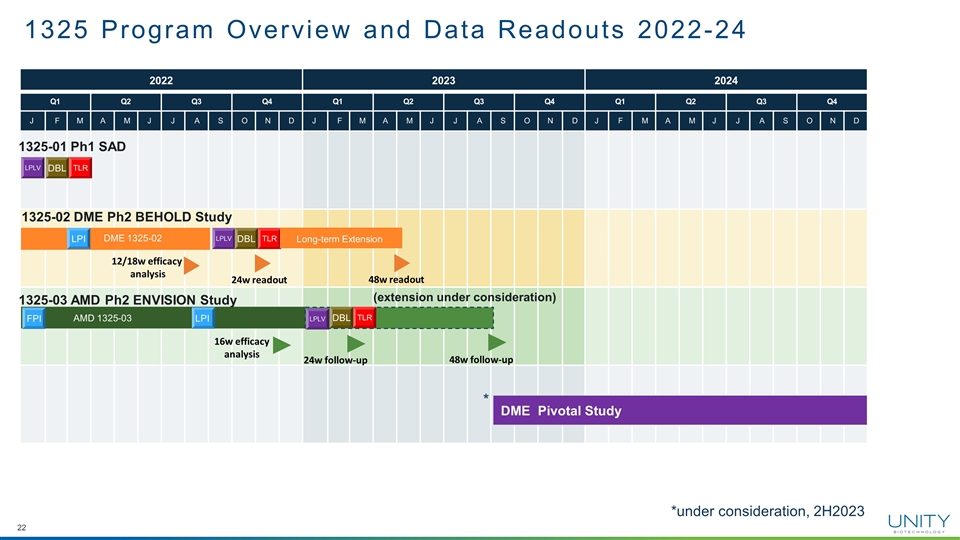
2022 2023 2024 Q1 Q2 Q3 Q4 Q1 Q2 Q3 Q4 Q1 Q2 Q3 Q4 J F M A M J J A S O N D J F M A M J J A S O N D J F M A M J J A S O N D LPI LPLV LPLV DME 1325-02 TLR DBL TLR DBL 1325-01 Ph1 SAD 12/18w efficacy analysis AMD 1325-03 LPI 16w efficacy analysis 24w follow-up DME Pivotal Study 48w follow-up TLR DBL 24w readout 1325-02 DME Ph2 BEHOLD Study 1325-03 AMD Ph2 ENVISION Study FPI 1325 Program Overview and Data Readouts 2022-24 (extension under consideration) Long-term Extension 48w readout LPLV * *under consideration, 2H2023
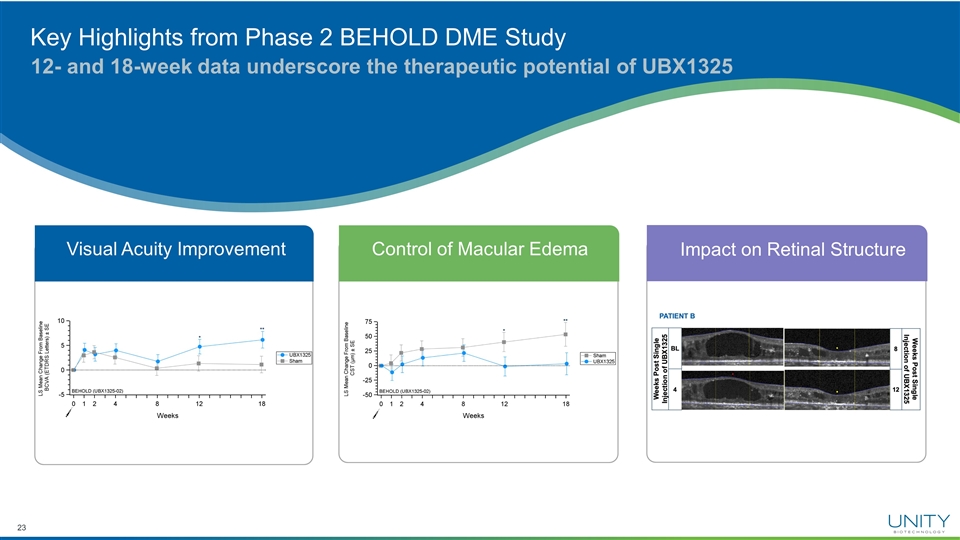
Key Highlights from Phase 2 BEHOLD DME Study 12- and 18-week data underscore the therapeutic potential of UBX1325 Visual Acuity Improvement Control of Macular Edema Impact on Retinal Structure






















